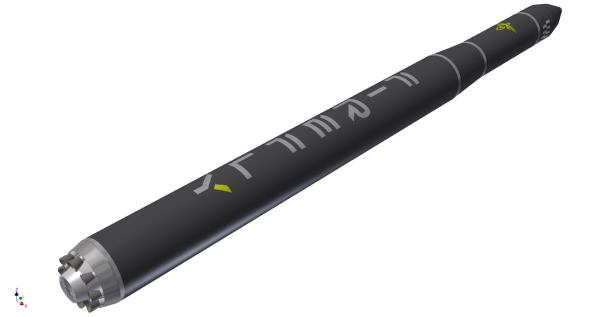If there’s one thing we can’t have enough of it’s different companies providing access to space. Whilst much of the progress in the private space industry might be attributable to a couple companies they will need some healthy competition in order to keep them in check, lest they fall into the same traps that their old space predecessors did. Indeed many of these new space companies that are cropping up are pursuing technologies that others have let slip by the wayside, some of which deserve thorough investigation. Firefly Space Systems, founded at the beginning of this year by a former SpaceX engineer, is the latest company to try its hand at providing access to space and it’s doing so in a very novel way.
Shown above is the concept for their Firefly Alpha which employs several novel technologies that you likely won’t have seen on any other craft before. For starters much of the launch body will be made of composite materials, similar to that of other private space start up Rocket Lab. The engines on the bottom are also noteworthy as they’re arranged as a plug-type aerospike, an engine type that’s been built (and tested) by numerous parties in the past but has never been used in a production craft before. The design also incorporates an autogenous (self pressurizing) fuel system, something which has the potential to make the craft far more efficient than other designs. All in all the design is quite impressive as the trade-offs it makes are radically different to those of more traditional rocket designs.
It’s going to be interesting to see how the composite designs perform as whilst the idea has been somewhat validated by Rocket Lab there’s yet to be a full sized rocket launch using it. Should the idea scale up to the levels that both Firefly and Rocket Lab require then there’s a lot of potential for their systems to be far more efficient than their more traditional brethren, although I’m sure there’s some trade offs that will have to be made. What they are and whether or not they’re worth it is something I can’t really determine (I am not a rocket scientist) but I’d doubt the drawbacks would be that severe considering 2 independent companies are pursuing it.
I’ve always been a fan of the aerospike design, mostly because the pure torodial ones look like something out of science fiction, but I know the reason why they’ve never made their way into a production craft. They’re a jack-of-all trades deal, maintaining approximately the same efficiency under all circumstances whilst not really excelling in any one of them. Traditional rocket design accommodated this by using different types of engines during different stages, something which has worked pretty well for pretty much all launch platforms. The question that Firefly will have to answer is whether the trade off of better efficiency closer to sea level (something all current rocket engines struggle with) outweighs the reduced efficiency in a vacuum when compared to the bell type engines. I’m sure the modelling they’ve done tells them yes but nothing beats real data when it comes to rocketry.
The real secret sauce of their design might be in the self-pressurizing fuel tanks, something which I’m not sure I’ve seen in any other rocket design before. In traditional rockets as the fuel is depleted it’s replaced by a pressurized gas so that the pressure within the tank remains constant. This means that you have to carry that gas and its associated systems with you, reducing your overall payload capacity. Firefly’s system instead uses it’s own fuel, in this case methane, which is routed around the aerospike to cool it (a common technique) and then pumped back into the fuel chamber as a gas. Then once all the fuel is spent the gas can also be used to provide a last bit of thrust, something the inert gas style models can’t readily achieve. If it works the way they say it does there’s quite a lot of potential for this plucky rocket as that little bit of extra efficiency could be enough to offset all their other trade offs.
All in all I like Firefly’s rocket design as it incorporates both novel design decisions as well as trade offs that most traditional rocket companies don’t make. The overall system could end up being vastly more efficient than its individual components, something which I don’t think many other launch companies consider when looking at these technologies in isolation. Whether it will all come together is something we’ll be waiting a while for though as this nascent company likely won’t be launching anything for a couple years. Still I’m eager to see what they can accomplish as we can never have too many people tackling the issue of getting access to space.




